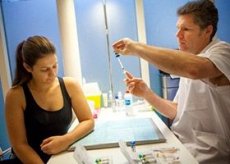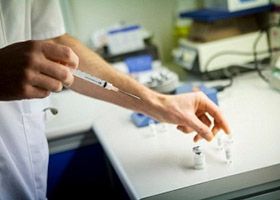Medical expert of the article
New publications
Treatment of panhypopituitarism
Last reviewed: 06.07.2025

All iLive content is medically reviewed or fact checked to ensure as much factual accuracy as possible.
We have strict sourcing guidelines and only link to reputable media sites, academic research institutions and, whenever possible, medically peer reviewed studies. Note that the numbers in parentheses ([1], [2], etc.) are clickable links to these studies.
If you feel that any of our content is inaccurate, out-of-date, or otherwise questionable, please select it and press Ctrl + Enter.

Treatment of hypothalamic-pituitary insufficiency should be aimed at compensating for hormonal insufficiency and, where possible, eliminating the cause of the disease. In clinical practice, hormonal preparations of peripheral endocrine glands are used predominantly, and to a lesser extent, missing tropic hormones of the adenohypophysis (due to the absence or insufficiency and high cost of pure preparations of human hormones). A significant obstacle to the use of preparations of pituitary hormones is the rapid development of refractoriness to them due to an increase in the level of antibodies.
In the case of a disease with primary destruction of the pituitary gland and rapidly progressive emaciation (Simmonds' pituitary cachexia), therapy is practically ineffective. Timely treatment of postpartum hypopituitarism (Sheehan's syndrome) is much more effective. Regardless of the nature of the disease, in all forms of organic hypopituitarism, treatment must be persistent, systematic, and almost always carried out throughout life.
A tumor or cyst causing destruction in the pituitary gland or hypothalamus is subject to radical treatment (surgery, radiation, administration of radioactive yttrium, cryodestruction).
Forms of the disease caused by acute or chronic infection are treated with special or anti-inflammatory drugs.
Hormone replacement therapy usually begins with adrenal cortex preparations, sex preparations, and, last of all, thyroid preparations. Oral medications are used to eliminate hypocorticism, but in severe cases, treatment begins with parenteral agents. Glucocorticoids are prescribed: hydrocortisone (50-200 mg daily), and when hypocorticism symptoms decrease, they switch to prednisolone (5-15 mg) or cortisone (25-75 mg/day). Mineralocorticoid deficiency is eliminated with 0.5% deoxycorticosterone acetate (DOXA) - 0.5-1 ml intramuscularly daily, every other day or 1-2 times a week, then switching to sublingual tablets of 5 mg 1-2 times a day. A 2.5% suspension of deoxycorticosterone trimethyl acetate of two-week prolongation is also used. In case of severe hypotension, subcutaneous implantation of a DOXA crystal containing 100 mg of the hormone, with a duration of action of 4-6 months, is effective.
During replacement therapy with corticosteroids (10-15 days after its start), ACTH (corticotropin) of short or (better) prolonged (24-30 hours) action is added. Treatment begins with small doses - 0.3-0.5 ml per day (7-10 U), gradually increasing the dose to 20 U daily. For courses repeated every 6-12 months - 400-1000 U. Greater efficiency and better tolerability are observed when using synthetic corticotropin with a shortened polypeptide chain - "synacthen-depot" for parenteral administration (1 ml - 100 U - 1-3 times a week).
Insufficiency of the sex glands is compensated in women with estrogens and progestins, and in men - with androgenic drugs. Treatment with sex hormones is combined with the introduction of gonadotropins. Replacement therapy in women artificially recreates the menstrual cycle. Estrogens are administered for 15-20 days (for example, microfollin at 0.05 mg per day) and in the following 6 days - gestagens (pregnin - 10 mg 3 times a day or 1-2.5% progesterone 1 ml daily; Turinal - 1 tablet 3 times a day). After preliminary treatment with sex hormones and reduction of atrophic processes in the genitals, gonadotropins are prescribed, it is also desirable to cyclically use follicle-stimulating menopausal gonadotropin at 300-400 IU every other day for the first 2 weeks, and luteinizing (chorionic) at 1000-1500 IU in the following 2 weeks. To stimulate the gonadotropic function in case of its partial or functional insufficiency, clostilbegyt is used at 50-100 mg for 5-9 or 5-11 days of the cycle. Sometimes chorionic gonadotropin is added to estrogens on the 12th, 14th and 16th day of the cycle, i.e. during the period of expected ovulation. In Sheehan's syndrome with a long history of the disease, when it is no longer possible to count on the stimulating effect of the introduction of gonadotropins, synthetic combined progestin-estrogen drugs (infekundin, bisecurin, non-ovlon, rigevidon, triziston) are used for substitution purposes. In addition to the specific effect on the reproductive system, the corresponding hormones have a positive trophic and anabolic effect.
For replacement purposes in men, methyltestosterone is administered at 5 mg 3 times a day sublingually, testosterone propionate at 25 mg 2-3 times a week intramuscularly, or prolonged-release drugs: 10% testenate solution at 1 ml every 10-15 days, sustanon-250 at 1 ml once every 3-4 weeks. Androgen replacement therapy at a young age alternates with the administration of chorionic gonadotropin at 500-1500 IU 2-3 times a week in repeated courses of 3-4 weeks. For oligospermia of varying degrees, clostilbegyt is used at 50-100 mg in courses of 30 days.
 Thyroid insufficiency is eliminated by thyroid hormones administered simultaneously with corticosteroids, since the increase in metabolic processes aggravates hypocorticism. Treatment begins with thyroidin at 0.025-0.05 mg and triiodothyronine at 3-5 mcg daily with a very slow increase in dose to 0.1-0.2 mg and 20-50 mcg, respectively, under the control of heart rate and ECG. In recent years, synthetic combination drugs containing thyroxine and triiodothyronine (thyreocomb, thyrotom) have been used predominantly. Caution in the administration of thyroid drugs is determined not only by hypocorticism, but also by the increased sensitivity of the myocardium of patients with hypothyroidism to them and the need for gradual adaptation in this regard.
Thyroid insufficiency is eliminated by thyroid hormones administered simultaneously with corticosteroids, since the increase in metabolic processes aggravates hypocorticism. Treatment begins with thyroidin at 0.025-0.05 mg and triiodothyronine at 3-5 mcg daily with a very slow increase in dose to 0.1-0.2 mg and 20-50 mcg, respectively, under the control of heart rate and ECG. In recent years, synthetic combination drugs containing thyroxine and triiodothyronine (thyreocomb, thyrotom) have been used predominantly. Caution in the administration of thyroid drugs is determined not only by hypocorticism, but also by the increased sensitivity of the myocardium of patients with hypothyroidism to them and the need for gradual adaptation in this regard.
Treatment of hypopituitaric coma includes high doses of parenteral corticosteroids, intravenous or subcutaneous administration of 5% glucose (500-1000 ml/day), vascular and cardiac agents.
Patients with panhypopituitarism require vitamins, anabolic hormones, and high-calorie, protein-rich nutrition. Targeted hormonal therapy - in cycles or continuously - is administered throughout life. The ability of patients to work is usually reduced.

